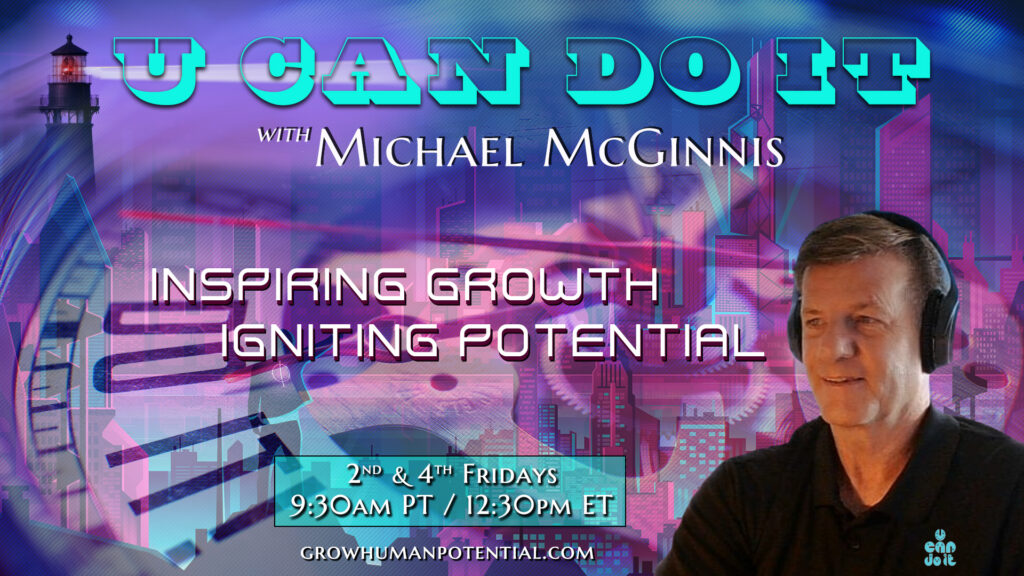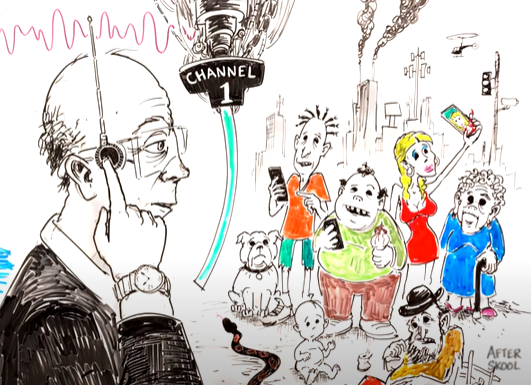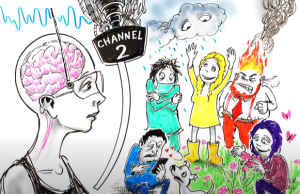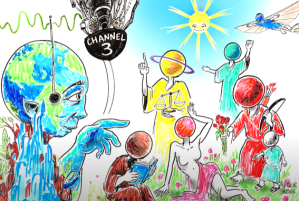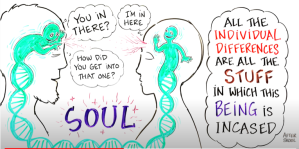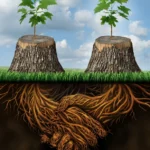The images and comments unless otherwise noted are from the video, “The Freedom of Being Nobody – Ram Dass” I encourage you to watch this 11:43 minute video. My thoughts and comments below are largely based on this video. This post, excluding the video, will be shared as a podcast soon. Click here for my podcast site.
Take a look at someone you do not know. What do you see? If we are honest with ourselves, what we see is strongly filtered by our own biases, prejudices, and judgements, which form our perceptions. Most of react based on what is in our subconscios which is where these filters reside. Personal growth is about increasing our awareness of what is in our subconscious so to understand our perceptions and the impact they have on our relationships and our own happiness. The great news is that we can change our beliefs, values, attitude and perceptions to result in a happier existance.
Let’s begin with learning about the various ways in which we can choose to see others. We begin with seeing another as “separate entities with a set of predisposing characteristics.” He refers to these different lenses as “channels” which are reviewed below. “Imagine” as Ram states, “that you have a control switch that you can adjust the way you look at another human being.”
Channel 1 – A Physical View
At the very basic level we “see a physical body (e.g. man, woman, old, young, fat, thin, pretty, handsome, ugly, etc.).” Take a moment and attempt to capture what you are thinking when you see, hear, smell, touch a person for the first time. This is the predominate channel that we use most of the time. We form a perception based on using our five senses. The perception is formed based on the judgements, beliefs and values we have developed over time which are stored in our conscious (what we know about ourselves) and subconscious (what we do not know about ourselves).
As a sensory being we focus on the physical first and foremost until we learn how to look beyond these senses. The challenge with the five-sensory view is that it is often combined with our perceptions which are a composite of our biases, prejudices, viewpoints, judgements, etc. Strong perceptions are formed with our initial glimpse of another, characterized by the quote, “judging a book by its cover”. If we are honest with ourselves, this is how we see others most of the time.
Channel 2 – A Psychological View
We consciously make a decision to switch over to Channel 2, a different way of looking at others. Here we focus on the psychological aspects associated with the individual. Once again this is largely based on our own observations and perceptions. What we see would be characterized using some of the following examples; manic depressive, narcistic, happy, angry, depressed, fearful, sad, anxiety, lonely, courageous, hopeful, optimitic, etc. Once we see at this level this is what we would consider to be “the real you where the physical body just carries this along”.
The observations we make are largely based on how a person behaves and acts. Since we have consciously learned at some point about these psychological characteristics and titles, we use these to label the individual. This is commonly used by counselors and therapists who are trained in psychology. Others may learn these characteristics formally or informally.
One example of this for me was when I was taking personality assessments. Each assessment uses your input to generate some data that can associate you with certain traits (e.g. introvert/extrovert) and/or preferences (e.g. approach towards conflict). As we learn these we may use this information as a filter in terms of how we see others (e.g. you are very introverted). This can be helpful in learning about another person particularly when you are establishing a connection with them, but this can also be used as a judgement which is what we need to be aware of (e.g. “Yes, Joe is very narcisistic. I can’t stand working with him). The challenge is that may only be using our observations to form this judgement. The key is using conversation to understand the person vs. judging them.
Channel 3 – A Classification View
As we evolve we learn ways to classify people. Examples of this include our birth sign (e.g. Scorpio) or using acronyms based on certain personality assessments (e.g. Mary is an ESTJ – an acronym classification from the Meyers-Briggs assessment). We group people into these classifications. Our observations are followed by a statement such as, “Oh, you must be a Libra”. This may be a broader view of someone but still carries with it some degree of limiting who someone is.
“Channels 1-3 focus on looking at individual differences”. It supports the view that we are all separate beings. Choosing the next channels is a quantum leap for many of us, particularly doing this consciously. For example, we may hear the expression that “we are all one” and even agree with this, but acting on this requires a great conscious effort along with learning how to do this with others.
Channel 4 – A Soul View
As you encounter another human being you look at their eyes. It does not matter what the physical, psychological or groupings are, for your focus is on their eyes, the window to their soul. “What you see is their soul, another soul who is just like you.” This vantage point produces no differences in individuals like Channels 1-3 do. It takes both a conscious effort to do this along with a belief that we each have a soul, source of light, etc.
This also supports the power of making strong eye contact with others. “Look me in the eye and tell me…” is often stated when we are in search for the truth with someone. It demonstrates how important eye contact can be. We can open a whole new level of a relationship.
My own experience with this supports the need for this to be a conscious effort. It is amazing how easy it is for our focus to detour off of the human subject. When I look at someone in the eye, I feel that I have to tell them the truth. I cannot explain why this is. It feels like I am connected at a higher level with this person when our eyes are connected, and from this that I have to speak the truth.
Channel 5 – A Oneness View
“You see yourself looking at yourself because on this channel we are all one and in a multiplicity of forms.” We have all heard the statement that “We Are One” but what does this really mean? It is the recognition and focus that we have all come from the same source, that we are the same source, so therefore how can we be different. This is in complete contrast with focusing from the physical plane (Channels 1-3) where we use our physical senses and ego to see differences.
In those rare occasions that I tune into this channel, the experience is extraordinary. The view into their eyes is often complimented with a heart warming smile. No words are needed since this vocabularly does not have words or need them. The only word that comes close is “namaste” which I understand means that the divine in me acknowledges the divine in you. “The “Divine in you” interpretation comes from the Hindu belief that God resides in everyone, so any person you greet deserves respect. “The gesture is an acknowledgment of the soul in one by the soul in another.” (Source)
I experience this in various capacities when I take time to truly understand another person. By taking the time to listen from the heart (with compassion) vs. the head (judgement, comparisons), the other person can feel truly heard. When I am able to empathize and relate to them, the connection grows closer. The differences that exist between us from a physical plane seem to dissolve as a heart-to-heart connection is made. We become one for a period of time.
Consider for a moment that we all came from a common source (dependant upon your beliefs). Does this not create a common level between us all? What if we were able to connect more from this common level than from a disparate level? Would the judgements we have even matter?
Channel 6 – A Consciousness View
“The physical all disppears, what Buddhists call the “Void”.
My interpretation of this would be what is left when we leave the physical form and/or what is within us that operates the physical body. You cannot cut open a body and see a soul. Consciousness is the energy that cannot be made or destroyed. It simply exists and in all corners of the Universe. Science is proving this concept through Quantum Physics and Mechanics (in a bit over my head here, but directionally correct).
If you got this far, I commend you since these concepts can be a real stretch to understand or consider. I have heard these concepts before mostly as a part of my spiritual search. To some degree I have also experienced these channels, less and less the higher the channel, but enough to accept and want to learn more. This would bring a whole new way to addressing the question, who are you? Ram shares an example.
“I am the Void, who manifests the one, who has a unique set of factors to work out thorugh a unique astral, psychological and physical body that is what I am doing here on Earth. I have taken a body to do certain work, and when I finish that work, I will discard this body. I repeat this process.”
Our journey is about being more deeply involved in life and yet less attached to it.
Ram Dass
Thought to Consider
Imagine the implications of developing similar channels to how you see others. As we begin to see the commonality between us, the differences begin to diminish and disappear. So many of the issues facing humanity would be confronted and dissolve since we see and feel a connection to everyone else. It would be easy to apply the principles of diversity and inclusion since we are one. It may take time to create your Soul, Oneness or Consciousness channels, but small baby steps here will demonstrate amazing results in your connections simply based on how you see others!!
About Michael
Michael is an award winning author, speaker, facilitator and coach on the topics of Career Coaching, Leadership, Personal Growth & Self-Discovery. Check out “Discovering Michael: An Inspirational Guide to Personal Growth & Self-Discovery” You can also view my latest development book on Leadership, “Leadership From The Inside Out: Building Your Leadership Foundation” which utilizes the concepts covered in this Framework to develop great leaders. Visit my website for more information (growhumanpotential.com) including links to my new YouTube Channel, “The Ripple Effect”, Podcasts and more. You can contact Michael at growhumanpotential@gmail.com


